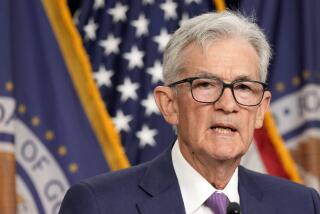Tough remedies stay on shelf amid refinancing fever
- Share via
WASHINGTON — In the 1990s, when Latin America and Asia were rocked by financial crises similar to the one now dogging the United States, Washington officials were quick with stern advice: Don’t bail out distressed banks. Don’t intervene when stock market and real estate bubbles pop. Let your overblown economies shrink to their natural levels.
“It was all, ‘You’ve got to be tough and take your castor oil,’ ” said Joseph E. Stiglitz, the Nobel Prize-winning economist, chairman of the Council of Economic Advisors under President Clinton and former vice president of the World Bank.
To date, U.S. officials haven’t followed any of the advice they so readily dispensed to others. They have tried to aid troubled banks. They have slashed interest rates to help the struggling housing and stock markets. They have made it clear that they will go to extreme lengths to keep the American economy out of recession.
But if the current prescription fails to provide long-term relief, what comes next? The answer, many economists say, could be that old castor oil.
“People are going to have to buckle up their seat belts and expect some dicey economic times for much of the year,” said William Grenier, chief investment officer at UMBS Management, a $12-billion asset management firm in Kansas City, Mo. “We’re going to have to let the excesses wash out of the system.”
Financial markets, battered in recent days on fears of a sharp U.S. economic downturn, showed signs of recovery Wednesday. The Dow Jones industrial average posted a gain of nearly 299 points, or 2.5%, after falling more than 300 points earlier in the trading session.
Coming a day after the Federal Reserve made the largest cut in its key interest rate in more than two decades to buoy the financial system, the rebound in share prices was greeted with great relief.
But as many economists and market players point out, the nation’s current economic problems have shown a disturbing tendency to outstrip assessments of their dimensions.
If that continues, it could force officials to consider stronger medicine than they have done -- perhaps even as strong as that they previously advised other nations to take.
So far, the Fed has taken the lead in efforts to bolster the economy from the effects of the housing bust and the resulting credit crunch that has strained the financial system.
After months of limited interest rate cuts and experiments with strategies for lending to cash-strapped banks, the Fed has begun easing credit in earnest.
On Tuesday, it slashed three-quarters of a point off the federal funds rate, the interest banks charge one another for short-term loans. Veteran Fed watchers believe that policymakers will knock an additional point or more off the rate in the coming months before they’re finished.
That could take the funds rate from 5.25%, where it was in September, to 2.25% or even lower. The rate is now 3.5%.
One problem with interest rate cuts as a solution to current troubles, however, is that a principal route by which they are turned into something that matters to ordinary people and spurs the economy is the housing market.
And this time around, the housing market is a mess, with too many properties for sale at prices that aren’t sustainable. Cheaper mortgage rates won’t easily cure those excesses, experts say.
A second problem is that the institutions chiefly responsible for transforming Fed cuts into lower borrowing rates -- the nation’s banks -- are deeply worried about their own finances because of mortgage-related losses.
That may mean they’ll be reluctant to pass along interest savings to individuals via loan rates, lessening the salutary effects of Fed action.
In addition to lower rates, President Bush and Democratic congressional leaders are trying to fashion a package of temporary tax cuts and spending increases designed to give the economy a quick boost.
Some in Congress want bolder steps. Several prominent lawmakers proposed Wednesday that Washington fashion 1930s-style investment programs to keep cash circulating -- for example, by launching big public works projects or reviving a New Deal agency that was created to stop home foreclosures.
Although he did not name a price tag, Senate Majority Leader Harry Reid (D-Nev.) called for a new program to build roads, utilities, schools and housing to boost employment and inject money into the economy.
Meanwhile, Sen. Christopher J. Dodd (D-Conn.) and Rep. Mark Steven Kirk (R-Ill.) proposed re-creating a federal agency to help homeowners refinance their homes.
Both are anathema to Bush and to budget hawks of both parties who fear the cost and say they would take too long to make a difference.
If Fed rate cuts are blunted by housing market weakness and banks’ hesitation to pass along interest savings, and new public spending or tax cuts end up mired in politics or arrive too late, there may be no other solution to the nation’s troubles than perhaps the most painful one: time.
That was, in effect, what the U.S. pushed on its Latin American and Asian counterparts during their crises. They were advised to stop trying to shield markets and simply accept dismal stretches for their economies while the problems sorted themselves out.
“The markets will find bottoms,” said Robert E. Litan, a senior fellow at the Brookings Institution. “Who knows how long it will take or how far they will have to fall? But they will find bottoms.”
He added, “It’s depressing, but there may not be much else to do” except wait.
The notion that the U.S. may have to practice what it preached to other nations holds a rich irony for many analysts.
“It’s just amazing the hypocrisy in which the U.S. has indulged,” said Gary C. Hufbauer, a senior economist with the Peterson Institute for International Economics in Washington.
“When other countries were causing financial contagions, we verbally spanked them for the lack of transparency in their financial systems and adequate regulations,” he said.
Now that the U.S. is the country causing the contagion -- with global stock markets plummeting earlier this week on fears of spillover from the American economy’s woes -- the root of the problem turns out to be remarkably similar, Hufbauer said: Financial institutions engaged in extraordinarily risky lending, using complex mortgage securities that defied understanding, with lax or nonexistent regulation.
America’s big bankers were supposed to be “so good at financial risk management, they could regulate themselves,” economist Stiglitz said. “It turns out these guys did very bad risk analysis and have created a mess.”
When Latin American and Asian countries found their finances in an analogous mess in the 1990s, Stiglitz said, “we told them, ‘You have to face the pain. . . . You can’t bail out people.’ ”
Most of those governments eventually let the turmoil take its course. The countries recovered, but not before going through the economic wringer -- for periods that in some cases lasted years.
--
More to Read
Inside the business of entertainment
The Wide Shot brings you news, analysis and insights on everything from streaming wars to production — and what it all means for the future.
You may occasionally receive promotional content from the Los Angeles Times.










